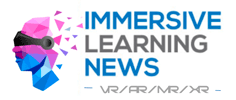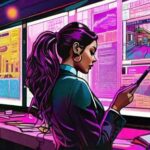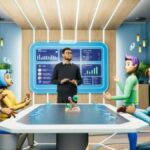Virtual reality (VR) is revolutionising the way we learn and experience education. From exploring ancient ruins to practicing surgical procedures, VR is providing students with immersive and engaging learning experiences. In this guide, we’ll explore the benefits of VR education and provide examples of how it’s being used in classrooms and beyond.
What is VR education and how does it work?
VR education is the use of virtual reality technology to enhance and transform the learning experience. It works by immersing students in a virtual environment that simulates real-world scenarios and allows them to interact with digital objects and characters. This technology can be used to teach a wide range of subjects, from history and science to art and language. By providing students with a more engaging and interactive learning experience, VR education can help improve retention and understanding of complex concepts.
Benefits of VR in education
There are many benefits to using VR in education. One of the biggest advantages is that it allows students to experience things that would be impossible or impractical to do in real life. For example, students can explore ancient ruins, travel to different parts of the world, or even visit outer space. This can help make learning more engaging and memorable. Additionally, VR can help students better understand complex concepts by allowing them to interact with digital objects and simulations. This can lead to improved retention and understanding of the material. Finally, VR can help level the playing field for students with different learning styles or abilities, as it provides a more immersive and personalised learning experience.
Examples of VR in education
There are many examples of how VR is being used in education. For example, medical students can use VR to practice surgeries and other procedures in a safe and controlled environment. History students can explore historical sites and events in a more immersive way. Science students can interact with digital simulations of complex concepts like molecular structures or the human body. And language students can practice speaking and listening skills in virtual environments that mimic real-life situations. These are just a few examples of how VR is transforming education and enhancing the learning experience for students of all ages.
How to implement VR in the classroom
Implementing VR in the classroom can seem daunting, but it doesn’t have to be. Start by identifying the learning objectives you want to achieve and then find VR experiences that align with those objectives. Consider partnering with VR companies or seeking out grants to fund the purchase of VR equipment. It’s also important to provide proper training for teachers and students on how to use the technology effectively. Finally, don’t forget to evaluate the effectiveness of VR in achieving learning objectives and adjust accordingly. With careful planning and implementation, VR can be a valuable tool for enhancing the classroom experience.
Future of VR in education
The future of VR in education is bright, with many experts predicting that it will become a standard tool in classrooms around the world. As the technology continues to improve and become more affordable, more schools and universities are likely to adopt VR as a way to enhance learning. In addition, VR has the potential to make education more accessible to students who may not have access to traditional classroom settings, such as those in remote or underserved areas. With its ability to create immersive and engaging learning experiences, VR is poised to revolutionise education in the years to come.
Our Platform – Metaverse Hub

Metaverse Hub offers a platform for schools, colleges, and universities to engage their students through our interactive virtual environment. With the ability to customise your teaching space, discover the best way for your students to learn and engage.
Quelle:



